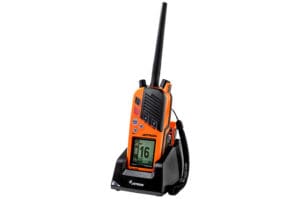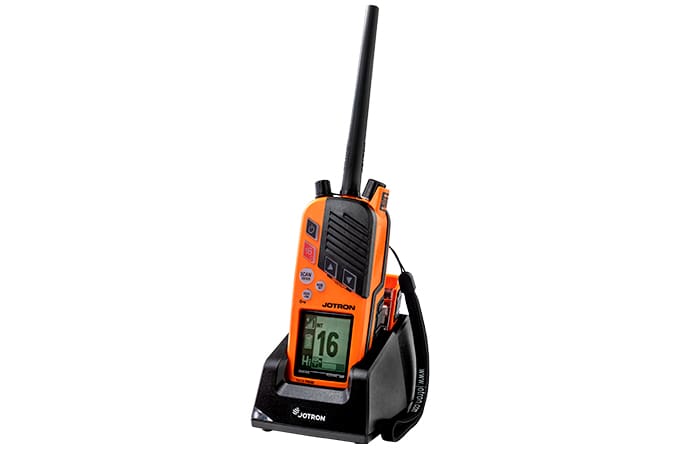
Probably the worst fear you can face as an offshore sailor is losing your vessel at sea. And while we definitely want to make sure we have a vessel-mounted and personal EPIRB ready to send out a distress signal immediately, we also need some means of communicating with rescue operations should this unthinkable horror ever come to pass.
Packing a survival VHF radio in your ditch bag is the best guarantee you will have voice communication with nearby ships. However, the ideal choice for this radio should include the ability to summon help beyond the typical eight-mile range of a handheld VHF radio.
To begin, any submersible, floating handheld VHF will serve the purpose of an emergency radio on a life raft as long as the batteries hold out. One should use the radio sparingly, attempting contacts only if there is another vessel visible on the horizon. Desperate calls to nowhere by panicked crew, or the foolhardy attempt to monitor radio traffic constantly, will gradually drain the battery and decrease your chances of being found.
The question we should ask is whether it is advisable to spend $600 or more on a GMDSS-rated handheld boasting long battery life and tough construction or a less expensive, non-GMDSS-rated handheld offering DSC and built-in GPS.
A piece of equipment stamped “GMDSS” (Global Maritime Distress and Safety) meets certain requirements for inclusion in a set of emergency equipment, particularly on commercial vessels. Cruising boats are not required to be GMDSS-equipped, so our choices of emergency equipment may be tailored to our own personal requirements.
The Tron TR30 GMDSS from Jotron is a “two-in-one” radio offering access to both GMDSS simplex channels and maritime duplex channels. This bright, emergency orange, floating handheld gives you access to both standard GMDSS channels and full maritime duplex channels.
Assuming your hands will be busy during an emergency situation, you can take advantage of the TR30’s ability to connect to an IP-67 speaker microphone or a headset with a PTT module. A small, compact, two-position charger is simple to install in your nav station.
When you connect the emergency battery to the TR30, the radio is automatically set in emergency mode. At this point, the only features available are those associated with emergency mode, preventing confusion and time wasted by the user.
ICOM’s GM1600 VHF marine transceiver offers the kind of tough construction demanded by the U.S. Coast Guard and international SOLAS (Safety of Life at Sea) regulations. Used on both commercial and pleasure vessels, the GM1600 is waterproof to 1 meter, and the lithium ion battery provides eight hours of operating time at temperatures ranging from -4 degrees F to 140 degrees F. The unit transmits at 1 or 2 watts, which is lower than standard VHF handhelds used primarily for voice communication.
ICOM’s bright yellow emergency handheld is intended for both emergency and routine communications. However, despite its durability, the GM1600 is a radio and nothing else, and a comparatively low-powered one at that.
Likewise, the ACR SR203 GMDSS Survival Radio offers only voice communications, but it does boast slightly higher output (2.5 watts) and 16 hours of battery life. As soon as the radio is activated, it is automatically tuned to channel 16 for emergency communications. The radio comes complete with a replaceable lithium battery, rechargeable lithium polymer battery, rapid battery charger, power adaptors, and a wall mount.
Whichever emergency VHF handheld you choose, make sure the unit is waterproof to at least one meter and has full GMDSS capability to ensure emergency-only communication when lives are at risk.

